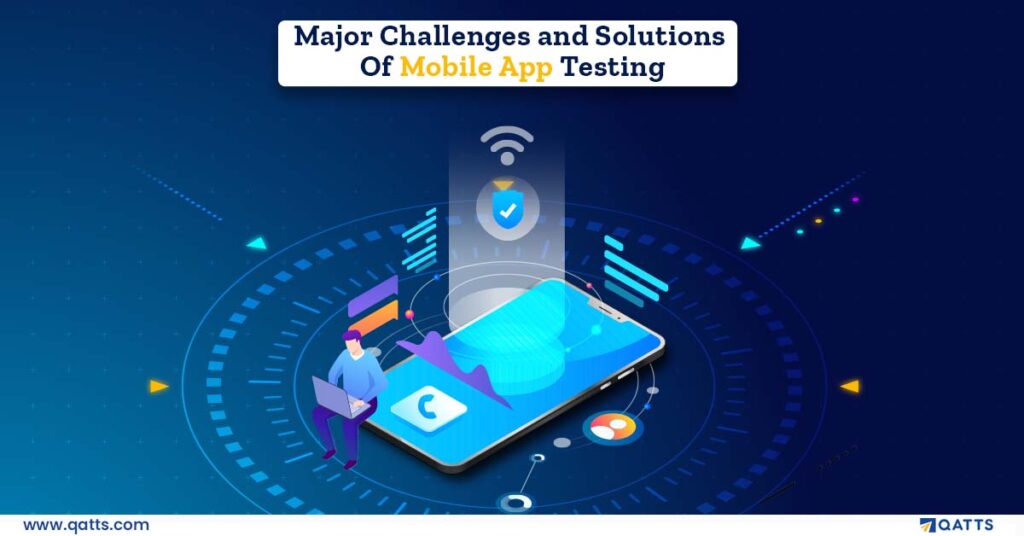
“First impression is the best impression”.
Make the first impression of your mobile app last long with high performance and excellent quality all the time.
After all, seamless UI/UX and quality assurance are what your customers needs for which you need to rely on mobile app testing or software testing services. We already have shared a detailed guide about it in our previous article titled “Here is the ultimate Checklist for Mobile App Testing in 2022”.
You might have been testing your app. Is your mobile application working as you expected or facing any challenges in mobile app testing?.
No doubt!. Every tester face challenges as there will be a phenomenal rise in the number of mobiles, models, operating systems and their versions, screen size specifications, network models, and many more. And your app must be tested across all these combinations to ensure well-functionality, well-performance, and quality across all.
Here are the major challenges in mobile testing and relevant solutions to tackle them
1. Device and Browser Fragmentation:
The number of devices such as a mobile, tablet, desktop, etc. in the market grows by 20% every year. And each device has its own operating system and each operating system launches new versions regularly for every 6 months.
On the other hand, there are many browsers such as Chrome, Mozilla, Safari, Firefox, Opera, etc. And each browser has multiple versions.
Each browser behaves differently on desktop and mobile. Combining all these, as per statistics, there were around 63,000 device-platform-browser combinations.
And your mobile app might not have universal interoperability on every possible combination of devices, operating systems and their versions, and browsers and their versions that are available in the market. So, this poses a major compatibility issue in mobile testing. Testers must ensure the mobile app works or functions the same across all device-platform-browser combinations.
How to fix it?
- l Through cloud-based mobile app testing
- l Using iOS simulators and Android emulators
- l Test the top 5-10 mobile devices and versions that have an active user base. You can get this information using Google Analytics.
2. Multiple screen specifications:
If there’s one thing that’s ever-changing in mobile devices is screen size. Each model will have multiple variants, different screen sizes, and resolutions. Generally, a mobile application is designed with a single screen as a reference.
However, UI components differ from one screen size to another screen size. And the screen sizes are very important in the case of UI/UX testing.
How to fix it?
- Resize the apps or adjust them to multiple resolutions so that we can maintain consistency across all the devices.
- Using dynamic layouts and elements while designing an app.
- We have various simulators and emulators which are used for different OSs and platforms.
- Using mobile testing labs where testers can these multiple devices at a time.
3. App Types:
We have various types of mobile applications such as Native Apps, Web Apps, Hybrid Apps, Progressive Web Apps, etc. As the implementation is different from one another, test case scenarios of each type of app differ from one another. They mainly differ in incompatibility, stress, and performance testing.
Native and Hybrid apps must be tested for successful download, execution, behavior, and platform interaction. Web apps must be tested on various browser-version combinations All these are prone to mobile testing challenges.
How to fix it?
A common solution is to eliminate at least one or both of the alternatives so that testers can avoid the complexity of multiple app architectures.
4. A wide variety of testing tools:
Unlike manual testing, we are available with various free and paid automation testing tools for Native, Web, iOS, Android, etc. The challenge is what tool and how many tools is/are the right fit for the mobile app that is going to be tested.
How to fix it?
One-size-fits-all will never be a solution. There are some tools such as Qatts that offer customized solutions to various testing needs. So, it is recommended to choose the right software testing tool that can thoroughly analyze the exact testing needs and choose the right tool for them.
5. Different types of networks
Networks and connections have a huge impact on the behavior of mobile apps. Mobile app users may switch from one network to another network. And the mobile app you build must work or function the same on both high-speed Wi-Fi and low-speed 2G network. Testers need to maintain the same performance across all networks. They need to test
- the app’s performance from 2G to 4G networks
- the accessibility of features offline
- the required transition time between the disconnection and getting reconnected.
How to fix it?
Test the apps on various network conditions and understand the response time for each. It will be an effective approach to tackle this challenge.
6. Security concerns:
Last but not least, this is the biggest challenge a tester face. Though cloud-based testing solutions are secure, a mobile app is subject to security vulnerability. Because the cache and poor or no encryption are prone to breaches.
- Using cross-browser testing tools
- Using cloud-based solutions like Qatts
How to fix it?
These solutions will assure you 100% accuracy and proximity to real-time data and user’s conditions.
These are to name a few. We will have a few more challenges that have an impact due to heavy battery usage/battery capacity variation, deadlines for the fast delivery of apps, various Mobile UIs, usability, internalization, various device-specific settings, diverse locations, third-party integrations, etc.
Conclusion:
The usage of the mobile app across the world is ever-growing. So, it is equally paramount to maintain a superior quality of any type of mobile application to stand tall and succeed.
So, make an informed decision about the approach or solution for the mobile app testing challenges. And make sure your app is user-friendly, intuitive, and bug-free.


